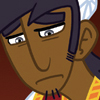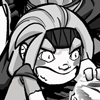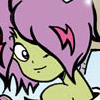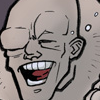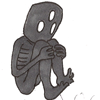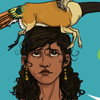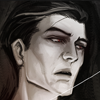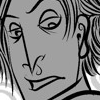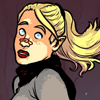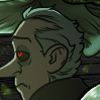Monthly Archives: August 2008
The Webcomic Overlook #53: Powerpuff Girls Doujinshi

One of the questions I get asked often is: “El Santo, how come you never cover webcomic fanfiction?”
OK, I so I never actually get asked the question. Ever. Heck, you’re probably kicking yourself because now you know that webcomic fanfiction exists, and you can do nothing to scrub that terrible thought from your brain. “Out, damn spot!” as the Lady MacBeth would say.
As a side note, video game comments are almost alway except from such discussions. Kate Tiedrich of Awkward Zombie writes stories using Super Smash Brothers as a background. And just recently I did a review of Scott Kurtz and his comic about the World of Warcraft. The practice is so prevalent in videogame webcomics that fanfiction never crosses the minds of most readers.
I’m talking about the hard stuff. Such as a dramatic (and surprisingly well drawn) Chip & Dale Rescue Rangers fanfiction. Once upon a time, I had considered reviewing this fine work (which, if I can be serious for a moment here, actually does contain some decent art), but I ran into a major stumbling block. Mainly, that I would actually have to sit down and read a Chip & Dale Rescue Rangers fanfiction. And you know how most of those go, right? Hint: most writers have an unhealthy obsession with Gadget. And then there’s Stink Child Comics. Its premise? The author’s self-insert is hopelessly in love with Kim Possible. Yeah, at this point there’s nothing the comic can do to earn more than one star. To go any further would be awfully mean spirited.
So instead I focus my energies on a comic that has been on hiatus since 2006, but which I have good reason to believe may, at any point, be suddenly resurrected to once again prey on our unguarded minds. It’s a comic that, in 2007, was one of the most searched topics on Comixpedia. And, somehow, this comic has won two Web Cartoonists Choice Awards. And not for some totally mde-up category like Best Fanfiction Comic or Doujinshi Superstar something. No, it won for legitimate-sounding awards like “Oustanding Superhero Comic” and “Outstanding Character.” Ah, yes, this is why the WCCA’s get so much respect among the media and webcomic professionals.
Today, The Webcomic Overlook reviews a little something called Powerpuff Girls Doujinshi.
Websnark’s Eric Burns-White on criticism

This was too good of a picture NOT to use.
Over at Websnark, Eric Burns-White posts a lengthy essay on criticism. I’m still not sure what to think of it. It’s the sort of piece that you have to read several times to let the points soak in.
Here’s an excerpt:
I’ve beaten this drum before, but there are really three definitions of criticism in use today, which have had the unfortunate effect of muddying the waters for everyone involved. In no particular order:
1. Criticism is the interpretation or analysis of creative work, attempting to discern both technique and meaning within one of many potential contexts. This is the one Kris Straub will make fun of me over — criticism in this definition refers to working out what an artist has done and how he has done it. While the analysis is necessarily subjective, this definition is less about judgement and more about interpretation. There are lots of “critical theories” that critics of this stripe subscribe to, ranging from traditional analysis through political filters like Marxism or Feminism (or any other -isms you care to apply) up to modern and post-modern theories like the (quite old) “New criticism” through the esoterica of Deconstructionism. When you read literary journals, this is ostensibly the kind of criticism you’ll find.
2. Criticism is the judgement rendered by (theoretically) qualified, (hopefully) impartial analyst over the effectiveness of given creative work at meeting its intentions and the suitability of the work to popular enjoyment. This is an overly highfalutin’ way of saying “Critics review shit.” This is the Roger Ebert side of Criticism — it may touch on aesthetics or artistic merit or the like, but generally it says “this work is good and you should consume it” or “this work sucks and you should shun it,” or some value in between the extremes. When we make references to film critics, book critics, theater critics, the old television cartoon The Critic or the like, almost always we’re referring to Reviewers like this. Any time you’ve seen stars or thumbs as part of a criticial essay, you’re reading a review.
3. Criticism means pointing out the flaws in someone or someone’s work. This is unquestionably the most popular day-to-day usage. “Do you mind some constructive criticism?” “To be critical for a moment….” “If you can’t take criticism maybe you shouldn’t ask my opinion.” And so on and so forth. Criticism is innately negative, in this definition — it isn’t about what people do right, or how well a given work (or given person) accomplishes its goals, it’s about they’ve done it wrong. Criticism is innately negative under this definition, and the only good that can come from it is reform.
You can see the problem, I trust. Someone can work diligently under the first definition of criticism and be conflated with the third by virtue of terminology. Reviewers and analysts becomes one thing, and the people who read their essays will expect elements of both somewhere in the work. It’s not enough to describe how something is done — the majority of the audience wants to hear whether or not the work’s any damn good.
Eric goes on to discuss whether or not a criticism can be criticized.
I mention the artists above essentially to dispose of them. The question at the top of the essay remains. Can criticism be criticized?
I was unequivocal in saying ‘yes.’ Of course criticism can be criticized. More to the point, all criticism is subject to all three definitions of criticism given above, just like any other produced work, regardless if the criticism itself falls under the first, second or third definition.
Incidentally, that guy named “Rook” from the Tad Williams message board mentioned at the beginning of the article?
That’s me.
Joy of Webcomics III: Interview and Blog edition
- Mike Schramm, a Chicago-based freelance writer, recently did an interview with The Abominable Charles Christopher‘s creator Karl Kerschl. Mr. Kerschl talks about his time at Marvel and DC (and I gotta admit I had no idea he once worked at the Big Two), his process on making a webcomic (where he joins the Brotherhood of G4 PowerBook users), and what the different characters in his comic represent. The Abominable Charles Christopher (reviewed here) is an excellent comic, an Eisner Award nominee and, in my opinion, the comic that should’ve won that award.
Read Mike Schramm’s interview here.
- I’ve added a link on my Blogroll for This Week in Webcomics, Jackson’s fun little blog about his webcomic reading passions. In many ways, the blog has a breezy, starry-eyed atmosphere that The Webcomic Overlook strives for. Bah, that’s what I get for being an irascible curmudgeon. You kids get off mah properteh! Anyway, I love his writing, even if he does think that my Dresden Codak review on Comixtalk qualifies as “positive hype.” 😉
- I really should’ve posted this last week, but Sly Eagle makes her reviewing debut on my old stomping grounds at Comic Fencing. Check it out!
Incidentally, the recent Gunnerkrigg Court group of reviews caused huge waves at two of the webcomic forums that I typically frequent. It was surreal seeing links to them, to say the least. No, I didn’t out myself as one of the reviewers (nor did I respond in any way; it seemed like bad form). The ways of the Shaolin are to lurk in the shadows, waiting to strike.
- That Penny Arcade Expo is going to totally get all up in your grill Seattle-style soon (EDIT: in 2 days apparently). I won’t be going (despite being from here), but I won’t judge you if you end up there dressed up like Yoko. In fact, I encourage it. And hey, you may get a chance to meet SCOTT KURTZ! You know, to either shake his hand or give him the malocchio, depending on if you agreed with him with the recent critic spat or not.
Kurtzchat: Your guide to the PvP Onomatopoeia controversy
Recently, on PvP, Scott Kurtz introduced a cadre of villains nominally named the Algonquin Hate Table (or The Sophisticates) as part of his current LOLBat storyline.
However, the strip was updated moments later.
Catch the change? Here, I’ll make it easy for you.

As it turns out, unbeknownst to Kurtz, the character of Onomatopoeia had already become cannon in DC Comics. He was created by Kevin Smith (of Clerks and Jay & Silent Bob Strike Back fame) as an enemy to Green Lantern. He shared a similar gimmick, as well as a similar costume.

So when his fans noted the similarity, Kurtz had an “Oh, sh**!” moment and redesigned the character. (Although, in my opinion, the new character of The Palindrome bears a visual similarity to this guy.)

I’m going to believe Scott Kurtz’s blog post, and that this was all some freaky coincidence. After all, there are only a few things you can do when your villain is named Onomatopoeia, all of which are awesome. What I don’t understand is the complete gimmick shift. “The Palindrome”? The new dialogue is already giving me headaches. (I am not a fan of Buckley’s Chef Brian character in CAD, and these lines are reminding me of him. A lot.) Is Kurtz going to redraw ever panel that formerly featured Onomatopoeia and replace all dialogue with nonsensical jibber jabber?
Secondly, I think Kurtz could’ve easily gotten around the whole Onomatopoeia thing by simply re-naming they guy. How about this: Foley Man. (Named after the Foley sound effects used for movies. No relation to WWE Superstar Mick Foley.) All that would require would be a slight costume change. No dialogue change needed.
Oh, sure… fans in the know would still connect Foley Man with Kevin Smith’s Onomatopoeia, but is that so bad? Are you telling me the weasel guy isn’t some sort of take on the Penguin?
Of course, now that I’ve thrown out the Foley Man idea, Kurtz can’t possibly use him because everyone would now say that he took his idea from me. So Palindrome it is.
FULL DISCLOSURE: This blog post was solely created to have yet another Scott Kurtz related post this month, easing the transition to when this site is re-named “The Scott Kurtz Overlook.”
Kurtz, Kurtz, Kurtz!
EDIT: Smith Michaels of the Blurred Productions blog theorizes that Savage Critic is a stand-in for Johanna Carlson, whose review touched the whole “Critic vs. Artist” debate. Supporting evidence? Ms. Carlson used to write for a site called “The Savage Critic.” Hmmmmm….
(If it is a jab, I’d consider it somewhat tongue-in-cheek, especially since Scott and Johanna have had more or less a civil encounter on ComixTalk and Newsrama.)
One Punch Reviews #17: Ding!

Kurtz, Kurtz, Kurtz!
What is it with all the Scott Kurtz stuff on this site, anyway? First his lampooning by Triumph the Insult Comic Dog, then his comments about webcomic critics, then his Webcomic Weekly counter-agruments about the comments from webcomic critics. Is there any way to escape form Scott Kurtz? In short: NO! Absolutely not! This site is going to feed you more Kurtz than you can possibly stand! For you shall have so much Scott Kurtz it will be coming into and out of your wazoo. YOUR WAZOO! It’s almost Biblical, if you think about like, the the copious amounts of quail the Israelites had to consume in the Wilderness.
If you think this is the lead in to a PvP review, well… I don’t every really plan on ever reviewing that comic. Frankly, PvP Makes Me Sad does it better. (Despite the title, PvP doesn’t always make blogger “Fake Scott McCloud” sad.) And, besides, the site’s archives are a murder to waddle through. You know, I get Scott’s mission statement that his strip is supposed to be read like one you’d find in newspapers. That is, miss the daily strips, and you’re out of luck until the book compilation comes out. But, c’mon, man, this is the age of the Internet! Instant Getification and all that.
Anyway, I’m taking on the far more managable Ding!, Kurtz’s take on the World of Warcraft culture. I might be out of my league here, by the way, since I don’t even play World of Warcraft. Heck, I hardly play MMORPGS. My only exposure is the low-tech, highly text-based variety where your character in the world map is represented by a generic Men’s Bathroom icon.
Is this fair, to review something with specialized in-jokes tailor made for fans? Hey, you’re reading the site that once dared to review a webcomic created for Transformers toy collectors. Let’s continue.
The Webcomic Overlook #52: Erfworld

In Tad Williams’ The War of the Flowers, protagonist Theo Vilmos is the singer for a modern day rock band. After discovering his uncle’s book, he is transported to a world inhabited by fairies, trolls, and other mystical creatures. Understandably, Theo is disoriented, but at the same time he’s awed by the fantastic new sights in this magical realm.
Mr. Williams is hardly the only author to write about a person from present day who suddenly finds themselves in a fantasy land. There’s Terry Brooks’ Magic Kingdom of Landover series, J. V. Jones’ The Barbed Coil, and John Norman’s Gor series. There aren’t many other examples beyond the ones you find in juvenile fantasy novels and fanfiction … at least, not enough for Wikipedia to rank it as one of the major subgenres of fantasy literature. Is this because a modern day protagonist in a fantasy world is far too much an exercise in escapism, even for the kind of reader who regularly reads books with covers featuring fearsome dragons, heroic knights, and damsels in loose-fitting gowns? Or perhaps because we have a sneaky suspicion that the hero is a Mary Sue of the author?
In a way, though, sticking a modern hero in a strange, distant world hews closer to traditional speculative fiction. Jonathan Swift, Jules Verne, and Arthur Conan Doyle all featured then modern-day heroes voyaging to highly exotic locales, like, say, an underground cavern filled with dinosaurs. Really, is this so very wrong? Since J.R.R. Tolkien spread his influence on the literary world, modern day fantasy fiction writers seem obsessed with writing novels that mimic fictional historical narratives. The peasant heroes must be products of their time, immune to the realm’s wondrous charms.
And yet, almost all introduce a naive young hero, a handy device to introduce several of the world’s high concept ideas to the reader. The more accurate the hero gets to being a product of his time, the more the author distance himself from the reader. It gets to the point where authors almost always portray the hero to believe the stereotype that women are weak and reserved, and then witness an ass-kicking warrior female only to conclude, “Hey, chicks are our equal after all!” some 500 years before women were granted the right to vote. Characters written in this fashion really are no different than time travelers, dimension hoppers, and wardrobe travelers who share more modern mores.
Which brings us to the subject of today’s Webcomic Overlook, Rob Balder and Jamie Noguchi’s Erfworld … or, as it’s better known, “The One Comic on the Giantitp.com site That’s Not Order of the Stick.”
Webcomics Weekly responds to the Critics! (With a capital “C”!)
It looks like Kris Straub, Brad Guigar, and Scott Kurtz have responded to the powderked touched off by Mr. Kurtz’s blog posts about critics.
Webcomics Weekly #44 – Everyone’s a Critic
A couple of key quotes:
Scott Kurtz: “I appreciate & read the works of critics.”
Kris Straub: “There’s inconsistency and difficulty in listening to unsolicited critiques.”
Scott Kurtz: “I just think it’s really easy right now to put up a blog and try to take your review and elevate that review out of its very noble purpose in either defending the new or protecting a consumer or advising a consumer and taking it to be its own creation, equal to that of what you are critiquing.”
Brad Guigar: “I think that’s perfectly fair to share your opinions with a work of art. But I think … anyone who acts in that role as a critic or a maker of opinions that you cross a line when you go from ‘Here’s what I thought’ to ‘Here’s what you should think.'”
I suggest listening to the podcast if you’re still interested in the critic vs. creator debate. (A surprise for listeners: Scott comes off as probably the most sympathetic to critics of the three.)
Kurtz also recites the Anton Ego quote from Ratatouille that I quoted on an earlier post. (OK, I’m not going to be so pretentious as to think he got it from this site. I mean, I imagine that artists of all types have this particular quote embedded inside their wallets.)
PS Stay around for a very intriguing battle between Kris Straub and Scott Kurtz over whether or not Fred Rogers from Mr. Rogers’ Neighborhood was creepy or not. (I’m with Mr. Straub on the “Mr. Rogers is a great guy” side of things.)











